MASERATI GRANTURISMO CONVERTIBLE 2019 Owners Manual
Manufacturer: MASERATI, Model Year: 2019, Model line: GRANTURISMO CONVERTIBLE, Model: MASERATI GRANTURISMO CONVERTIBLE 2019Pages: 296, PDF Size: 9.01 MB
Page 271 of 296
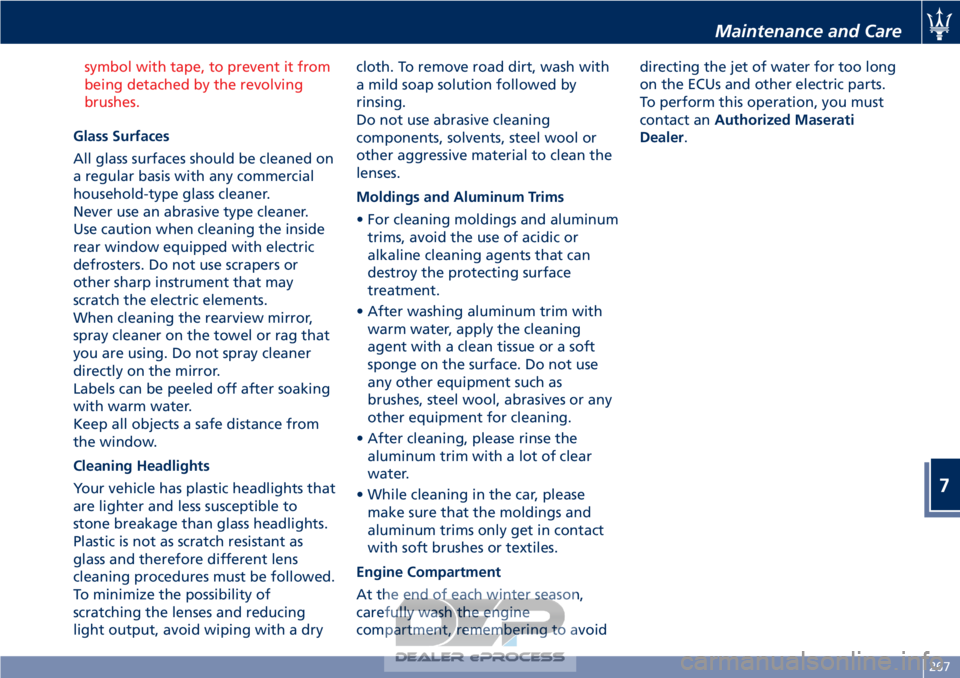
symbol with tape, to prevent it from
being detached by the revolving
brushes.
Glass Surfaces
All
glass surfaces should be cleaned on
a regular basis with any commercial
household-type glass cleaner.
Never use an abrasive type cleaner.
Use caution when cleaning the inside
rear window equipped with electric
defrosters. Do not use scrapers or
other sharp instrument that may
scratch the electric elements.
When cleaning the rearview mirror,
spray cleaner on the towel or rag that
you are using. Do not spray cleaner
directly on the mirror.
Labels can be peeled off after soaking
with warm water.
Keep all objects a safe distance from
the window.
Cleaning Headlights
Your vehicle has plastic headlights that
are lighter and less susceptible to
stone breakage than glass headlights.
Plastic is not as scratch resistant as
glass and therefore different lens
cleaning procedures must be followed.
To minimize the possibility of
scratching the lenses and reducing
light output, avoid wiping with a dry cloth. To remove road dirt, wash with
a mild soap solution followed by
rinsing.
Do not use abrasive cleaning
components, solvents, steel wool or
other aggressive material to clean the
lenses.
Moldings and Aluminum Trims
• For cleaning moldings and aluminum
trims, avoid the use of acidic or
alkaline cleaning agents that can
destroy the protecting surface
treatment.
• After washing aluminum trim with warm water, apply the cleaning
agent with a clean tissue or a soft
sponge on the surface. Do not use
any other equipment such as
brushes, steel wool, abrasives or any
other equipment for cleaning.
• After cleaning, please rinse the aluminum trim with a lot of clear
water.
• While cleaning in the car, please make sure that the moldings and
aluminum trims only get in contact
with soft brushes or textiles.
Engine Compartment
At the end of each winter season,
carefully wash the engine
compartment, remembering to avoid directing the jet of water for too long
on the ECUs and other electric parts.
To perform this operation, you must
contact an
Authorized Maserati
Dealer.
Maintenance and Care
7
267
Page 272 of 296
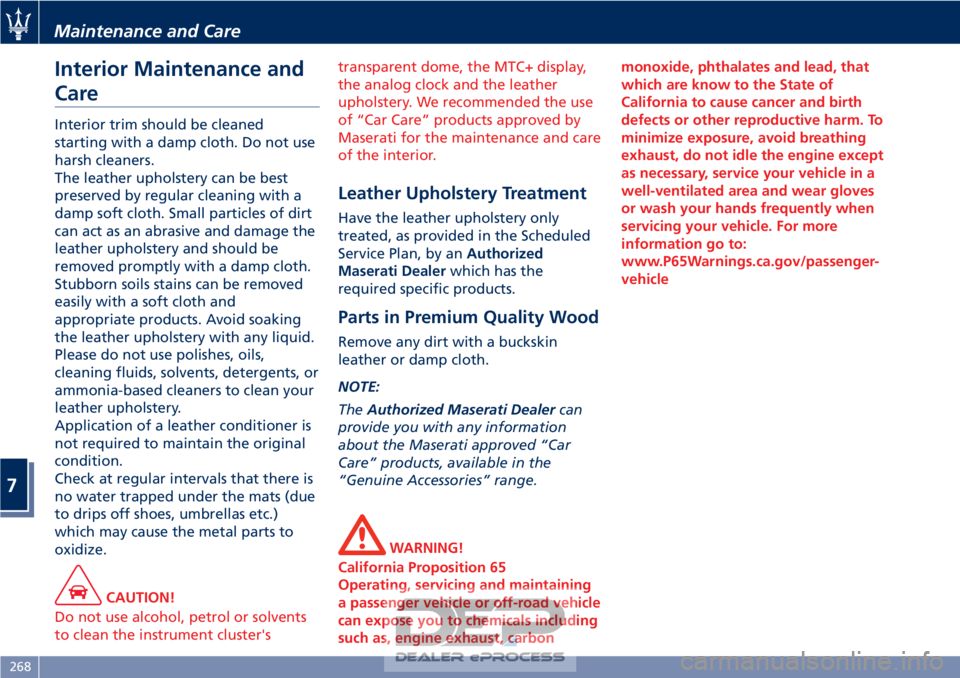
Interior Maintenance and
Care
Interior trim should be cleaned
starting with a damp cloth. Do not use
harsh cleaners.
The leather upholstery can be best
preserved by regular cleaning with a
damp soft cloth. Small particles of dirt
can act as an abrasive and damage the
leather upholstery and should be
removed promptly with a damp cloth.
Stubborn soils stains can be removed
easily with a soft cloth and
appropriate products. Avoid soaking
the leather upholstery with any liquid.
Please do not use polishes, oils,
cleaning fluids, solvents, detergents, or
ammonia-based cleaners to clean your
leather upholstery.
Application of a leather conditioner is
not required to maintain the original
condition.
Check at regular intervals that there is
no water trapped under the mats (due
to drips off shoes, umbrellas etc.)
which may cause the metal parts to
oxidize.
CAUTION!
Do not use alcohol, petrol or solvents
to clean the instrument cluster's transparent dome, the MTC+ display,
the analog clock and the leather
upholstery. We recommended the use
of “Car Care” products approved by
Maserati for the maintenance and care
of the interior.
Leather Upholstery Treatment
Have the leather upholstery only
treated, as provided in the Scheduled
Service Plan, by an
Authorized
Maserati Dealer which has the
required specific products.
Parts in Premium Quality Wood
Remove any dirt with a buckskin
leather or damp cloth.
NOTE:
The Authorized Maserati Dealer can
provide you with any information
about the Maserati approved “Car
Care” products, available in the
“Genuine Accessories” range.
WARNING!
California Proposition 65
Operating, servicing and maintaining
a passenger vehicle or off-road vehicle
can expose you to chemicals including
such as, engine exhaust, carbon monoxide, phthalates and lead, that
which are know to the State of
California to cause cancer and birth
defects or other reproductive harm. To
minimize exposure, avoid breathing
exhaust, do not idle the engine except
as necessary, service your vehicle in a
well-ventilated area and wear gloves
or wash your hands frequently when
servicing your vehicle. For more
information go to:
www.P65Warnings.ca.gov/passenger-
vehicle
Maintenance and Care
7
268
Page 273 of 296
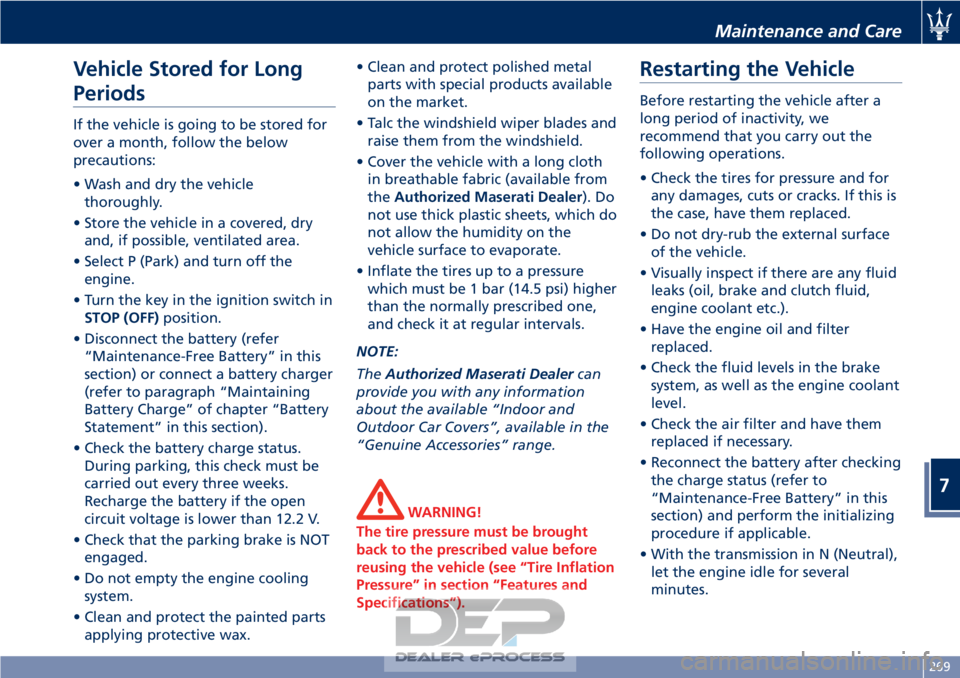
Vehicle Stored for Long
Periods
If the vehicle is going to be stored for
over a month, follow the below
precautions:
• Wash and dry the vehiclethoroughly.
• Store the vehicle in a covered, dry and, if possible, ventilated area.
• Select P (Park) and turn off the engine.
• Turn the key in the ignition switch in STOP (OFF) position.
• Disconnect the battery (refer “Maintenance-Free Battery” in this
section) or connect a battery charger
(refer to paragraph “Maintaining
Battery Charge” of chapter “Battery
Statement” in this section).
• Check the battery charge status. During parking, this check must be
carried out every three weeks.
Recharge the battery if the open
circuit voltage is lower than 12.2 V.
• Check that the parking brake is NOT engaged.
• Do not empty the engine cooling system.
• Clean and protect the painted parts applying protective wax. • Clean and protect polished metal
parts with special products available
on the market.
• Talc the windshield wiper blades and raise them from the windshield.
• Cover the vehicle with a long cloth in breathable fabric (available from
the Authorized Maserati Dealer ). Do
not use thick plastic sheets, which do
not allow the humidity on the
vehicle surface to evaporate.
• Inflate the tires up to a pressure which must be 1 bar (14.5 psi) higher
than the normally prescribed one,
and check it at regular intervals.
NOTE:
The Authorized Maserati Dealer can
provide you with any information
about the available “Indoor and
Outdoor Car Covers”, available in the
“Genuine Accessories” range.
WARNING!
The tire pressure must be brought
back to the prescribed value before
reusing the vehicle (see “Tire Inflation
Pressure” in section “Features and
Specifications”).
Restarting the Vehicle
Before restarting the vehicle after a
long period of inactivity, we
recommend that you carry out the
following operations.
• Check the tires for pressure and for any damages, cuts or cracks. If this is
the case, have them replaced.
• Do not dry-rub the external surface of the vehicle.
• Visually inspect if there are any fluid leaks (oil, brake and clutch fluid,
engine coolant etc.).
• Have the engine oil and filter replaced.
• Check the fluid levels in the brake system, as well as the engine coolant
level.
• Check the air filter and have them replaced if necessary.
• Reconnect the battery after checking the charge status (refer to
“Maintenance-Free Battery” in this
section) and perform the initializing
procedure if applicable.
• With the transmission in N (Neutral), let the engine idle for several
minutes.
Maintenance and Care
7
269
Page 274 of 296
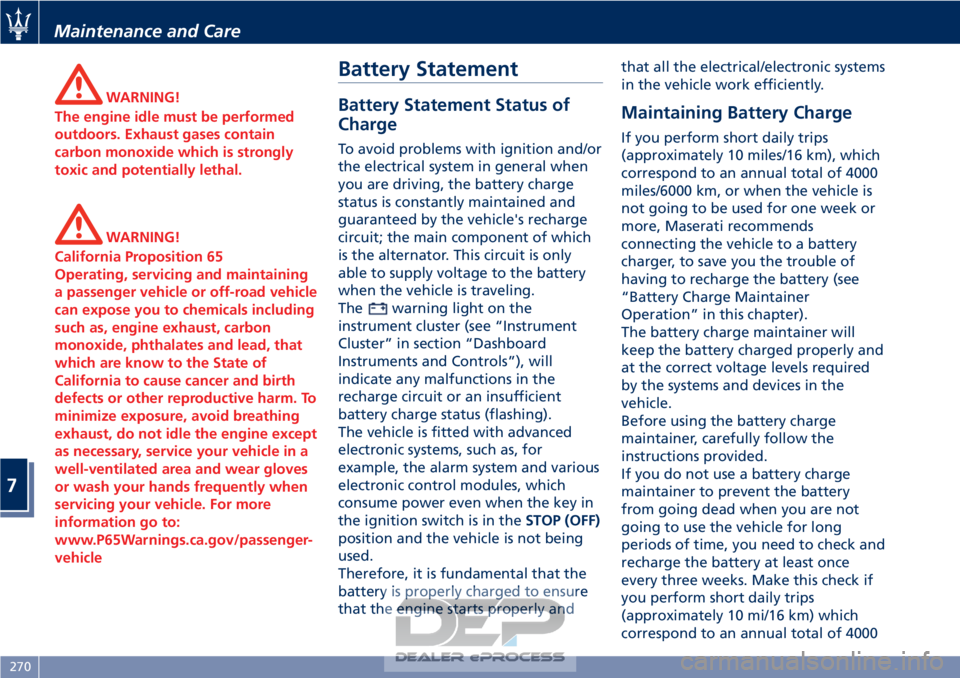
WARNING!
The engine idle must be performed
outdoors. Exhaust gases contain
carbon monoxide which is strongly
toxic and potentially lethal.
WARNING!
California Proposition 65
Operating, servicing and maintaining
a passenger vehicle or off-road vehicle
can expose you to chemicals including
such as, engine exhaust, carbon
monoxide, phthalates and lead, that
which are know to the State of
California to cause cancer and birth
defects or other reproductive harm. To
minimize exposure, avoid breathing
exhaust, do not idle the engine except
as necessary, service your vehicle in a
well-ventilated area and wear gloves
or wash your hands frequently when
servicing your vehicle. For more
information go to:
www.P65Warnings.ca.gov/passenger-
vehicle
Battery Statement
Battery Statement Status of
Charge
To avoid problems with ignition and/or
the electrical system in general when
you are driving, the battery charge
status is constantly maintained and
guaranteed by the vehicle's recharge
circuit; the main component of which
is the alternator. This circuit is only
able to supply voltage to the battery
when the vehicle is traveling.
The
warning light on the
instrument cluster (see “Instrument
Cluster” in section “Dashboard
Instruments and Controls”), will
indicate any malfunctions in the
recharge circuit or an insufficient
battery charge status (flashing).
The vehicle is fitted with advanced
electronic systems, such as, for
example, the alarm system and various
electronic control modules, which
consume power even when the key in
the ignition switch is in the STOP (OFF)
position and the vehicle is not being
used.
Therefore, it is fundamental that the
battery is properly charged to ensure
that the engine starts properly and that all the electrical/electronic systems
in the vehicle work efficiently.
Maintaining Battery Charge
If you perform short daily trips
(approximately 10 miles/16 km), which
correspond to an annual total of 4000
miles/6000 km, or when the vehicle is
not going to be used for one week or
more, Maserati recommends
connecting the vehicle to a battery
charger, to save you the trouble of
having to recharge the battery (see
“Battery Charge Maintainer
Operation” in this chapter).
The battery charge maintainer will
keep the battery charged properly and
at the correct voltage levels required
by the systems and devices in the
vehicle.
Before using the battery charge
maintainer, carefully follow the
instructions provided.
If you do not use a battery charge
maintainer to prevent the battery
from going dead when you are not
going to use the vehicle for long
periods of time, you need to check and
recharge the battery at least once
every three weeks. Make this check if
you perform short daily trips
(approximately 10 mi/16 km) which
correspond to an annual total of 4000
Maintenance and Care
7
270
Page 275 of 296
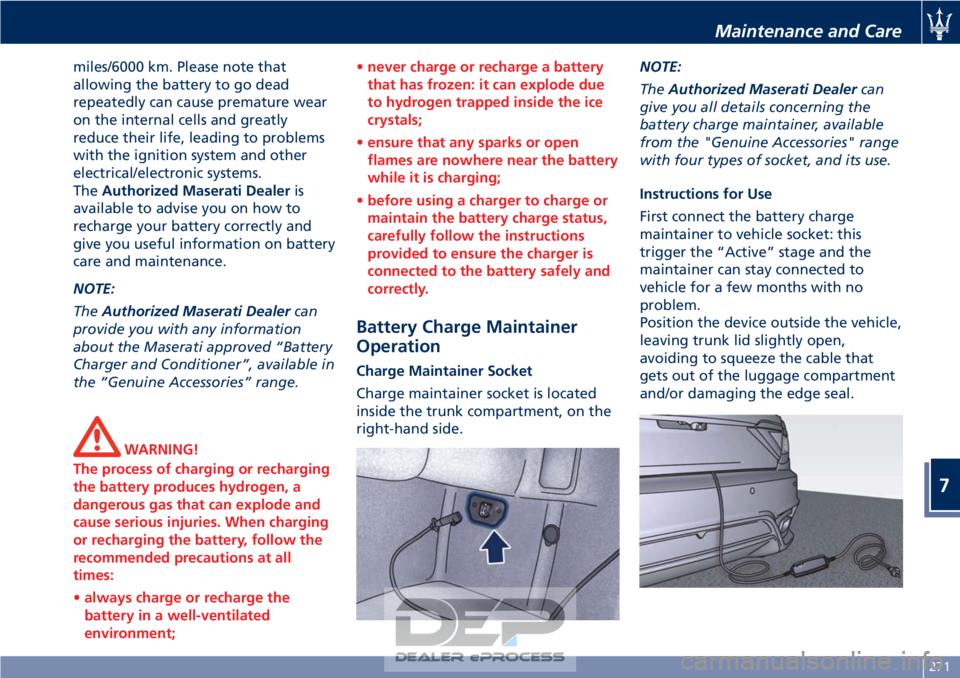
miles/6000 km. Please note that
allowing the battery to go dead
repeatedly can cause premature wear
on the internal cells and greatly
reduce their life, leading to problems
with the ignition system and other
electrical/electronic systems.
TheAuthorized Maserati Dealer is
available to advise you on how to
recharge your battery correctly and
give you useful information on battery
care and maintenance.
NOTE:
The Authorized Maserati Dealer can
provide you with any information
about the Maserati approved “Battery
Charger and Conditioner”, available in
the “Genuine Accessories” range.
WARNING!
The process of charging or recharging
the battery produces hydrogen, a
dangerous gas that can explode and
cause serious injuries. When charging
or recharging the battery, follow the
recommended precautions at all
times:
• always charge or recharge the
battery in a well-ventilated
environment; •
never charge or recharge a battery
that has frozen: it can explode due
to hydrogen trapped inside the ice
crystals;
• ensure that any sparks or open
flames are nowhere near the battery
while it is charging;
• before using a charger to charge or
maintain the battery charge status,
carefully follow the instructions
provided to ensure the charger is
connected to the battery safely and
correctly.
Battery Charge Maintainer
Operation
Charge Maintainer Socket
Charge maintainer socket is located
inside the trunk compartment, on the
right-hand side. NOTE:
The
Authorized Maserati Dealer can
give you all details concerning the
battery charge maintainer, available
from the "Genuine Accessories" range
with four types of socket, and its use.
Instructions for Use
First connect the battery charge
maintainer to vehicle socket: this
trigger the “Active” stage and the
maintainer can stay connected to
vehicle for a few months with no
problem.
Position the device outside the vehicle,
leaving trunk lid slightly open,
avoiding to squeeze the cable that
gets out of the luggage compartment
and/or damaging the edge seal.
Maintenance and Care
7
271
Page 276 of 296
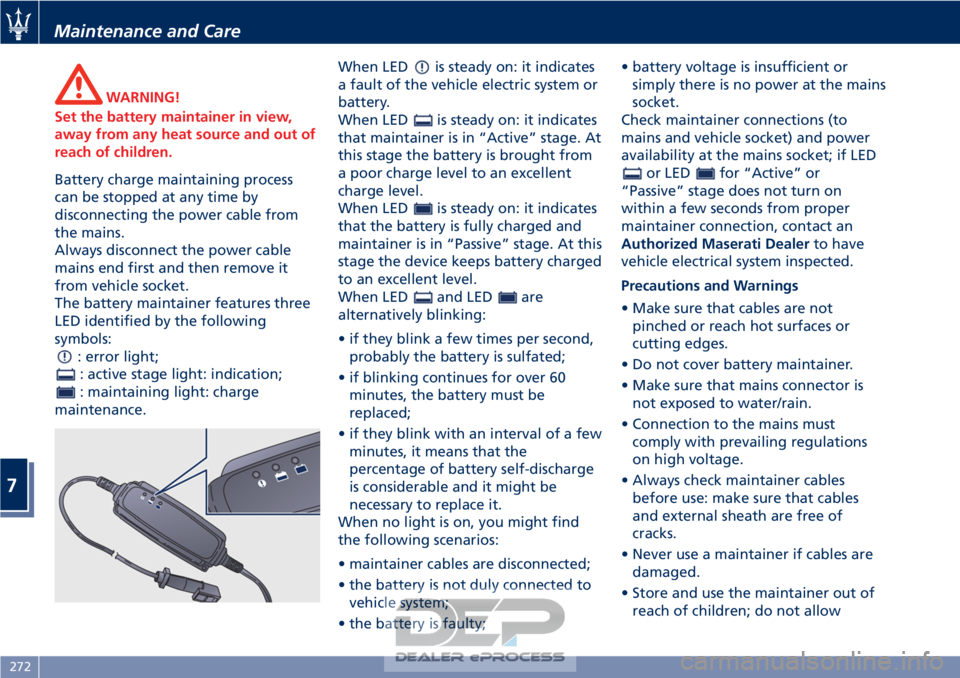
WARNING!
Set the battery maintainer in view,
away from any heat source and out of
reach of children.
Battery charge maintaining process
can
be stopped at any time by
disconnecting the power cable from
the mains.
Always disconnect the power cable
mains end first and then remove it
from vehicle socket.
The battery maintainer features three
LED identified by the following
symbols:
: error light;
: active stage light: indication;
: maintaining light: charge
maintenance. When LED
is steady on: it indicates
a fault of the vehicle electric system or
battery.
When LED
is steady on: it indicates
that maintainer is in “Active” stage. At
this stage the battery is brought from
a poor charge level to an excellent
charge level.
When LED
is steady on: it indicates
that the battery is fully charged and
maintainer is in “Passive” stage. At this
stage the device keeps battery charged
to an excellent level.
When LED
and LEDare
alternatively blinking:
• if they blink a few times per second, probably the battery is sulfated;
• if blinking continues for over 60 minutes, the battery must be
replaced;
• if they blink with an interval of a few minutes, it means that the
percentage of battery self-discharge
is considerable and it might be
necessary to replace it.
When no light is on, you might find
the following scenarios:
• maintainer cables are disconnected;
• the battery is not duly connected to vehicle system;
• the battery is faulty; • battery voltage is insufficient or
simply there is no power at the mains
socket.
Check maintainer connections (to
mains and vehicle socket) and power
availability at the mains socket; if LED
or LEDfor “Active” or
“Passive” stage does not turn on
within a few seconds from proper
maintainer connection, contact an
Authorized Maserati Dealer to have
vehicle electrical system inspected.
Precautions and Warnings
• Make sure that cables are not pinched or reach hot surfaces or
cutting edges.
• Do not cover battery maintainer.
• Make sure that mains connector is not exposed to water/rain.
• Connection to the mains must comply with prevailing regulations
on high voltage.
• Always check maintainer cables before use: make sure that cables
and external sheath are free of
cracks.
• Never use a maintainer if cables are damaged.
• Store and use the maintainer out of reach of children; do not allow
Maintenance and Care
7
272
Page 277 of 296
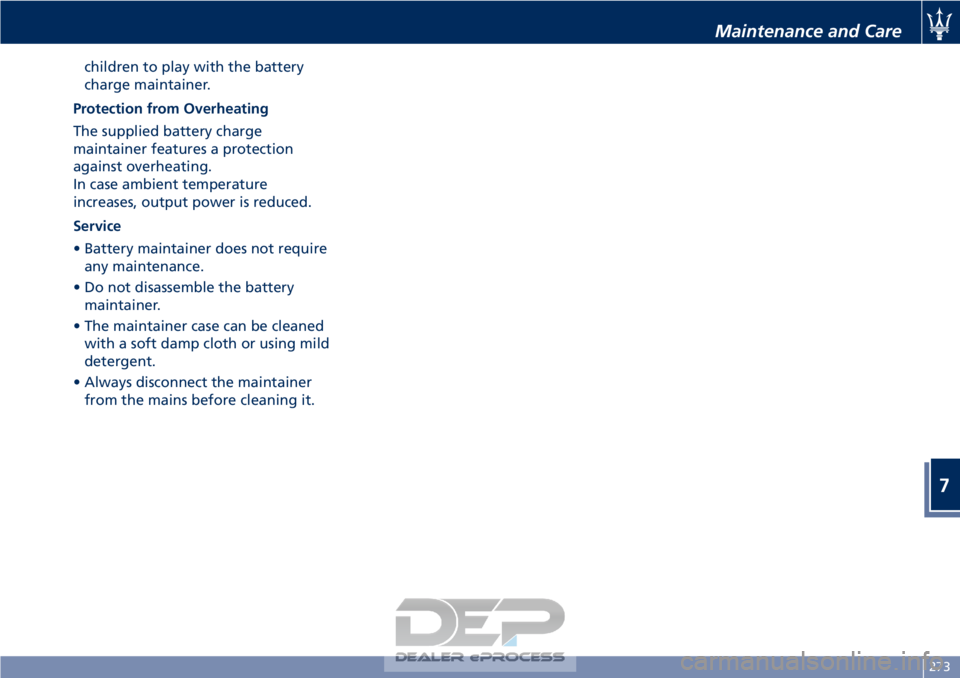
children to play with the battery
charge maintainer.
Protection from Overheating
The supplied battery charge
maintainer features a protection
against overheating.
In case ambient temperature
increases, output power is reduced.
Service
• Battery maintainer does not require any maintenance.
• Do not disassemble the battery maintainer.
• The maintainer case can be cleaned with a soft damp cloth or using mild
detergent.
• Always disconnect the maintainer from the mains before cleaning it.
Maintenance and Care
7
273
Page 278 of 296
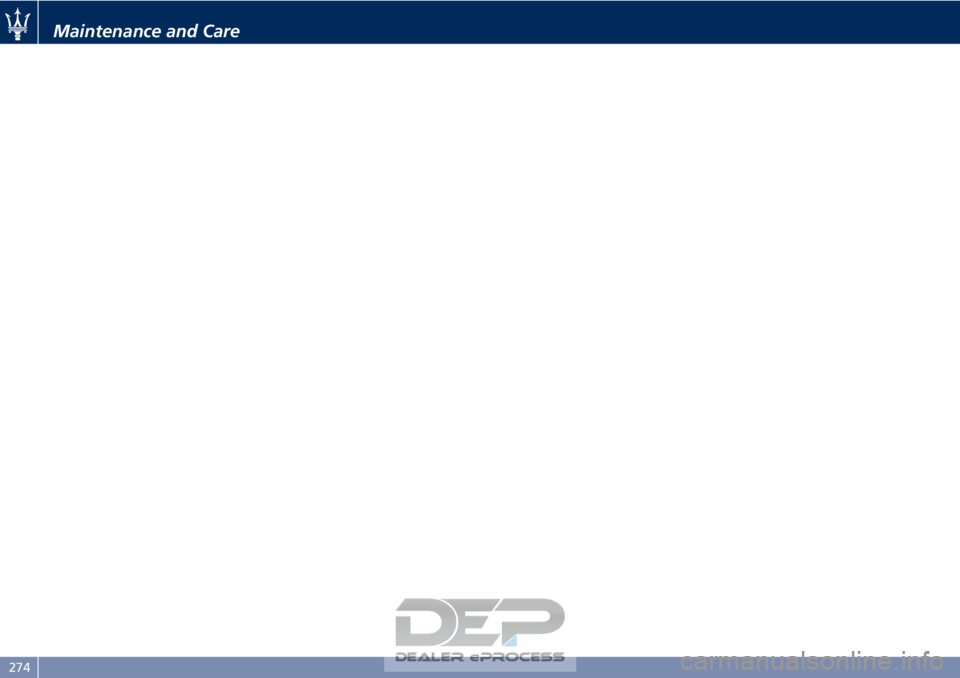
Maintenance and Care
274
Page 279 of 296
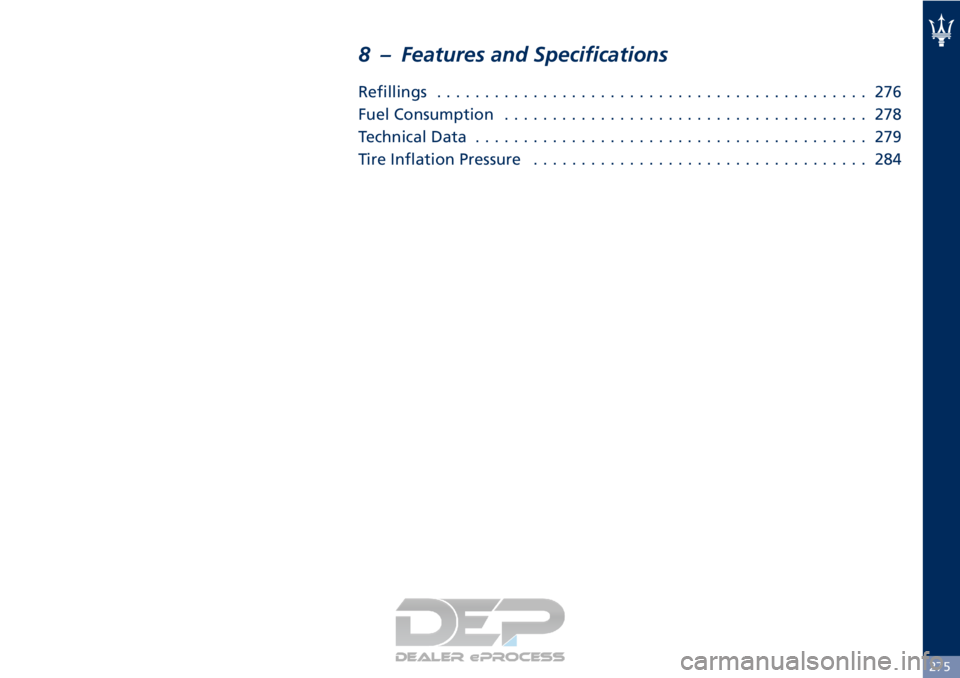
8 – Features and Specifications
Refillings............................................. 276
Fuel Consumption ...................................... 278
Technical Data ......................................... 279
Tire Inflation Pressure ................................... 284
275
Page 280 of 296
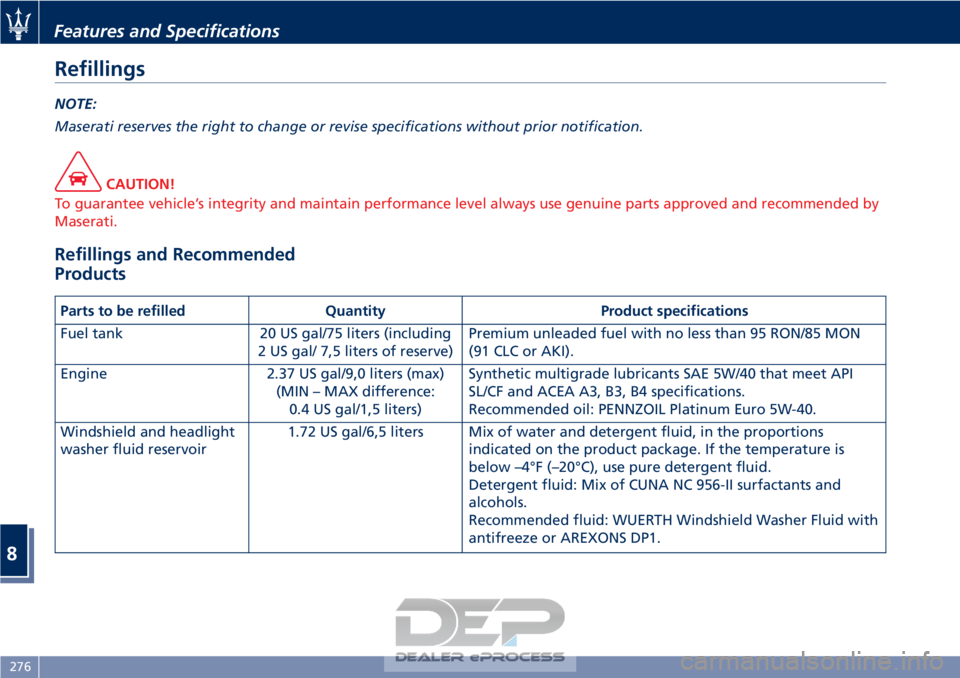
Refillings
NOTE:
Maserati reserves the right to change or revise specifications without prior notification.
CAUTION!
To guarantee vehicle’s integrity and maintain performance level always use genuine parts approved and recommended by
Maserati.
Refillings and Recommended
Products
Parts to be refilled Quantity Product specifications
Fuel tank 20 US gal/75 liters (including
2 US gal/ 7,5 liters of reserve) Premium unleaded fuel with no less than 95 RON/85 MON
(91 CLC or AKI).
Engine 2.37 US gal/9,0 liters (max)
(MIN – MAX difference: 0.4 US gal/1,5 liters) Synthetic multigrade lubricants SAE 5W/40 that meet API
SL/CF and ACEA A3, B3, B4 specifications.
Recommended oil: PENNZOIL Platinum Euro 5W-40.
Windshield and headlight
washer fluid reservoir 1.72 US gal/6,5 liters Mix of water and detergent fluid, in the proportions
indicated on the product package. If the temperature is
below –4°F (–20°C), use pure detergent fluid.
Detergent fluid: Mix of CUNA NC 956-II surfactants and
alcohols.
Recommended fluid: WUERTH Windshield Washer Fluid with
antifreeze or AREXONS DP1.
Features and Specifications
8
276